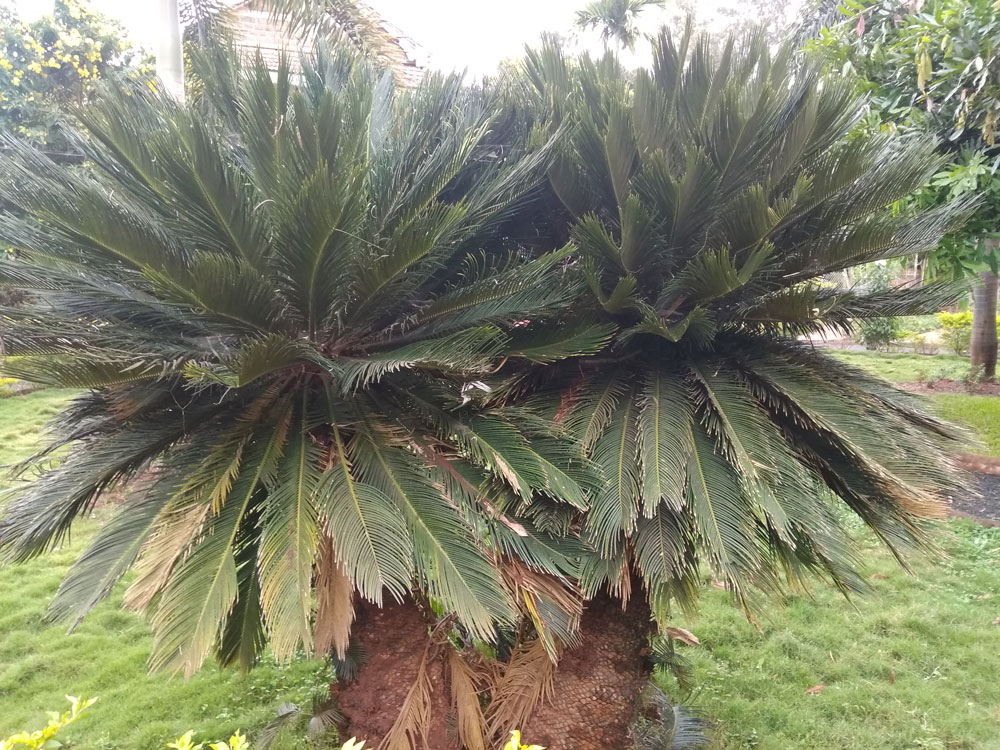queen sago - sago palm

Cycas circinalis
Summary
Scientific Classification
Kingdom: Plantae
Division: Tracheophyta
Class: Cycadopsida
Order: Cycadales
Family: Cycadaceae
Genus: Cycas
Species: C.circinalis
Scientific Name: Cycas circinalis L.
Common names
English :Sago Palm, queen sago.
Discription
- Habit and Habitat: :medium sized suckering cycad, growing 3 - 5 metres tall, exceptionally to 10 metres. is a stout palm-like plant with a trunk covered in thick and corky bark, it produces one or more, usually unbranched stems.
- Distribution: :: The plant is classified as ‘Endangered’ in the IUCN Red List of Threatened Species(2011). Cycas circinalis is restricted to southwest India.
- Morphology:
Leaf: bright green and semi glossy, rosette pattern about 280cm long ,flat in section. petiolate, petiole about 70cm long,partially or entirely spinescent. leaflets about 50-120(oppositely arranged), margins flat, midrib raised above and distinct below. emerging leaves have a glaucous sheen, young leaves are densly pubescent, older leaves are glabrous.
Cones: Male cone: Arise from the center of the top, light yellowish-brown to brown, egg-shaped to conical (24-)34-48, 12-15(-18) cm wide ,produces abundant pollen. Each microsporophyll is about 60 mm long and about 24 mm wide with a terminal spine 20-40 mm long.
Female cone: Like other Cycas species, the female plants do not bear cones; instead they carry ovules and seeds on large, feather-like megasporophylls which are about 35 cm long, having about 6-14 ovules, and an orange tomentum. The lamina/blade or sterile part of the megasporophylls about 40 mm long, about 35 mm wide rhomboid tapering into a long spine that is 15-35 mm long and 3-6 mm wide, strongly dentate or spinous toothed along margin. The 13-28 lateral spines are each about 4 mm long.
Seeds: small, sub-globular to elongated, about 40 mm long and 25 mm wide, they show a distinctive spongy, fibrous layer within the sarcotesta that allows them to float on water and are light-yellow, reddish-yellow or brown at maturity. - Propagation: by seeds.
- Importance:
a. All cycads have special upwardly growing multi-branched (coralloid) roots where nitrogen is fixed in symbiosis with Nostoc and Anabena algae.
b. A gum resembling tragacanth (obtained from Astragalus gummifer) exudes from wounds in the plant. Tragacanth has a wide range of uses including as a thickening agent in preparing dyes for calico printing, textile dyes and for dressing fabrics, it is also a thickener in making glues, water colours, ink (where it supplies a gloss), it is a binding agent in paper making, a culture medium in laboratories etc…
c. The bark and the seeds are ground to a paste with oil and used as a poultice on sores, cuts, wounds, ulcers and swellings. - Location:Botanical Garden, Entrance Garden.
 Trees of GSS Project supported by Makerspace Belgaum Website concept and designe by
Trees of GSS Project supported by Makerspace Belgaum Website concept and designe by